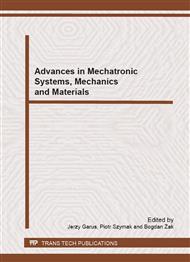[1]
P. J. Craven, R. Sutton and R. S. Burns: Control Strategies for Unmanned Underwater Vehicles in Journal of Navigation, Vol. 51, No. 2, (1998), pp.79-105.
DOI: 10.1017/s0373463397007601
Google Scholar
[2]
T. I. Fossen: Guidance and Control of Ocean Vehicles. John Wiley and Sons, Chichester (1994).
Google Scholar
[3]
T. I. Fossen: Marine Control Systems. Marine Cybernetics AS, Trondheim (2002).
Google Scholar
[4]
T. I. Fossen: Handbook of Marine Craft Hydrodynamics and Motion Control. John Wiley and Sons, Chichester (2011).
Google Scholar
[5]
J. Garus and Z. Kitowski: Tracking Autopilot for Underwater Robotic Vehicle in J. Cagnol and J.P. Zolesio (eds. ), Information Processing: Recent Mathematical Advances in Optimization and Control. Presses de l'Ecole des Mines de Paris, Paris (2004).
Google Scholar
[6]
J. Garus: Using of Soft Computing Techniques to Modelling of Motion of Underwater Robot under Conditions of Environmental Disturbances in Polish Journal of Environmental Studies, Vol. 16A, (2007), pp.34-38.
Google Scholar
[7]
B. Lantos and L. Muton: Nonlinear Control of Vehicles and Robots. Springer-Verlag, London (2011).
Google Scholar
[8]
J. Małecki: Model of Propeller for the Precision Control of Marine Vehicle in Solid State Phenomena, Vol. 180, (2012), pp.323-330.
DOI: 10.4028/www.scientific.net/ssp.180.323
Google Scholar
[9]
K. Ogata: Modern Control Engineering. Prentice Hall, New Jersey (2002).
Google Scholar
[10]
J. E. Slotine and W. Li: Applied Nonlinear Control. Prentice Hall, New Jersey (1991).
Google Scholar
[11]
F. Song, P. E. An and A. Folleco: Modelling and Simulation of Autonomous Underwater Vehicles: Design and Implementation in IEEE Journal of Oceanic Engineering, Vol. 28, No. 2, (2003), pp.283-296.
DOI: 10.1109/joe.2003.811893
Google Scholar
[12]
M. W. Spong and M. Vidyasagar: Robot Dynamics and Control, John Wiley and Sons, Chichester (1989).
Google Scholar
[13]
P. Szymak: Selection of Method for Underwater Robot Control i9 Solid State Phenomena, , Vol. 164, (2010), pp.149-154.
DOI: 10.4028/www.scientific.net/ssp.164.149
Google Scholar
[14]
D. R. Yoerger and J. E. Slotine: Robust Trajectory Control of Underwater Vehicles in IEEE Journal of Oceanic Engineering, No. 4, (1985), pp.462-470.
DOI: 10.1109/joe.1985.1145131
Google Scholar


